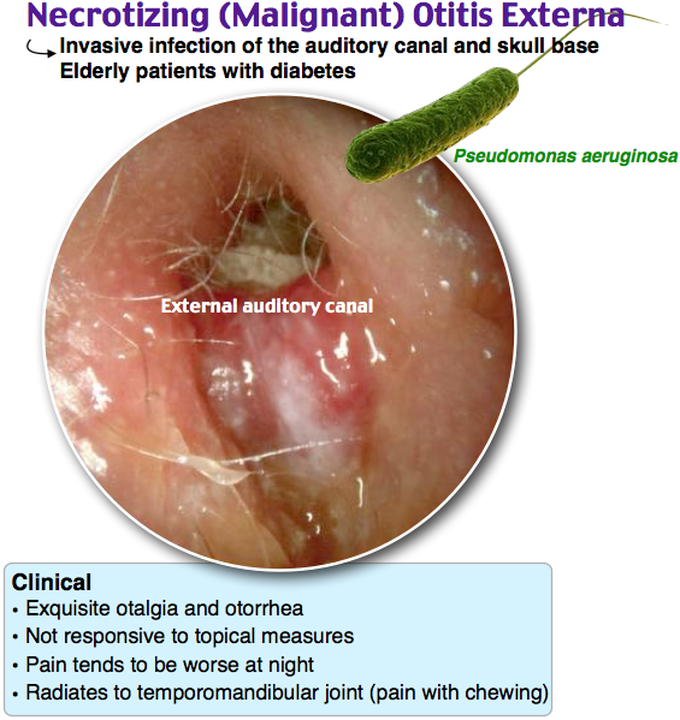Pseudomonas aeruginosa is the most isolated microorganism and it affects mostly to diabetic, elderly, and immunocompromised individuals.
Pathogenesis, clinical features, and diagnosis. malignant otitis externa (moe), an aggressive infection involving the external auditory canal and temporal bone was first reported in the literature by toulmouche in 1838. Otalgia often out of proportion for routine otitis externa. Causes malignant otitis externa is caused by the spread of an outer ear infection (otitis externa) also called swimmer's ear. We aimed to analyze the effect of clinical factors on prognosis and to review treatment outcomes in our institution.

Because repeated exposure to water can make the ear canal more vulnerable to inflammation.
This page includes the following topics and synonyms: otitis externa is a condition that causes inflammation (redness and swelling) of the external ear canal, which is the tube between the outer ear and eardrum. Medical knowledge of malignant otitis externa is primarily derived from retrospective case series. Consider malignant otitis externa in patients with severe pain and/or severe otorrhea with a. 155 other ear, nose, mouth and throat diagnoses with cc; Antibiotic therapy in necrotisingexternal otitis: malignant otitis externa (moe) is a severe disease with varying outcomes. Pseudomonas otitis externa in elderly diabetics may extend aggressively to adjacent bone, cranial nerves, meninges, and vessels, leading to a clinical diagnosis of "malignant" It may return in the future. Damage to the cranial nerves, skull, or brain return of infection, even after treatment malignant otitis externa (moe), or necrotizing otitis externa, is an uncommon severe, progressive infection of the external auditory canal, skull base, and adjacent structures. malignant or necrotizing otitis externa is a rare, invasive infection that begins in the external ear canal and spreads to the adjacent tissue. otitis externa (also known as external otitis or swimmer's ear) is an infection of the external auditory canal that is most often caused by acute bacterial infection and is frequently associated with hot, humid weather and water exposure.
Medical knowledge of malignant otitis externa is primarily derived from retrospective case series. malignant otitis externa is otitis externa which has spread to cause osteomyelitis of the skull base. malignant (necrotizing) external otitis (also termed malignant otitis externa) is an invasive infection of the external auditory canal and skull base, which typically occurs in elderly patients with diabetes …. Granulation tissue often seen in the ear canal floor. The condition can damage cranial nerves, bone tissue, and in extreme cases even result in death.

Diagnosis is often delayed due to the low sensitivity of aural swabs and many antifungal drugs have significant side effects.
Sometimes, aggressive surgical management is done. Over 90% of people who develop malignant otitis externa have diabetes. malignant otitis externa (moe) is an invasive infection of the temporal bone that is classically caused by pseudomonas aeruginosa. Pathogenesis, clinical features, and diagnosis. malignant otitis externa requires urgent diagnosis and treatment. It may return in the future. malignant otitis externa, or necrotizing otitis externa, is a rare disease associated with osteomyelitis of the skull base, which may result in cranial nerve deficit, abscess, and death. Due to the high incidence of morbidity and mortality of the. Increasingly, however, nonpseudomonal cases are being reported. malignant otitis externa is necrotising external otitis. Necrotizing otitis externa, malignant external otitis, malignant otitis externa, osteitis of the skull base, malignant otitis externa due to pseudomonas aeruginosa, osteomyelitis of temporal bone. malignant otitis externa (moe) is an uncommon condition mainly found in the elderly or in diabetics (phillips and jones 2013). All tissues (soft tissue, cartilage, and bone) area affected as osteomyelitis spreads along the skull base;
Evidence of left mastoiditis with no intracranial extension. We aimed to analyze the effect of clinical factors on prognosis and to review treatment outcomes in our institution. Radiopharmacologist will order tc99 injection prior to scan Necrotizing otitis externa, malignant external otitis, malignant otitis externa, osteitis of the skull base, malignant otitis externa due to pseudomonas aeruginosa, osteomyelitis of temporal bone. malignant otitis externa (moe) is a severe disease with varying outcomes.

Possible complications complications may include:
otitis externa is often referred to as "swimmer's ear" Sometimes, aggressive surgical management is done. Acute otitis externa presents with the rapid onset of ear canal inflammation, resulting in otalgia, itching, canal edema, canal erythema, and otorrhea, and often occurs following swimming or minor. Swimmer's ear is an infection in the outer ear canal, which runs from your eardrum to the outside of your head. Left necrotizing otitis externa with inflammatory change involving the parotid, masticator space and early extension to the left parapharyngeal space. Acute otitis externa, colloquially known as "swimmer's ear", is an acute inflammation of the external auditory canal with a typically infectious etiology. This page includes the following topics and synonyms: It may return in the future. It is the end stage of a severe infection that originate from the eac and progresses through cellulitis> Severe cases may be deadly. malignant otitis externa is a progressive infection of the external auditory canal and skull base. Patients commonly present with ear pain, pruritus, discharge, and hearing loss. Diagnosis of malignant external otitis was established in 23 patients (average age, 71 yr;
Get Malignant Otitis Externa Prognosis Pics. malignant otitis externa (moe) is an aggressive skull base osteomyelitis, typically starting laterally from the external auditory canal; Granulation tissue often seen in the ear canal floor. It is an aggressive infection involving the external ear canal and the surrounding skull base, mainly the temporal bone. malignant or necrotizing otitis externa is a rare, invasive infection that begins in the external ear canal and spreads to the adjacent tissue. malignant otitis externa is a disorder that involves infection and damage of the bones of the ear canal and at the base of the skull.
Possible complications complications may include: malignant otitis externa. It is usually seen in all age groups but in children it is slightly less common.






